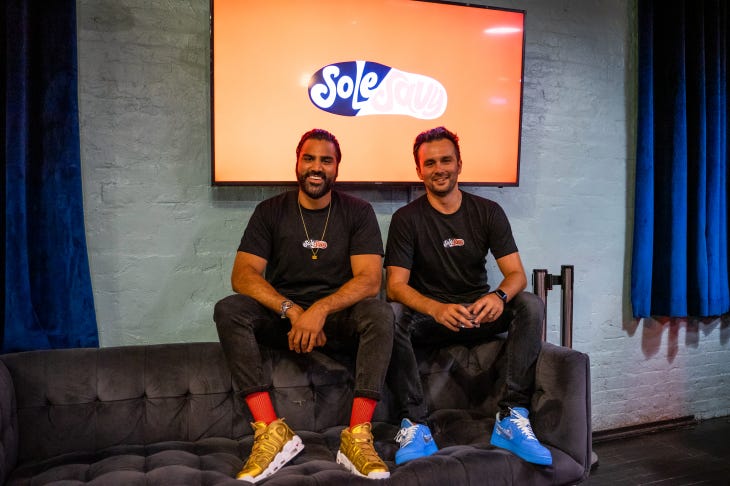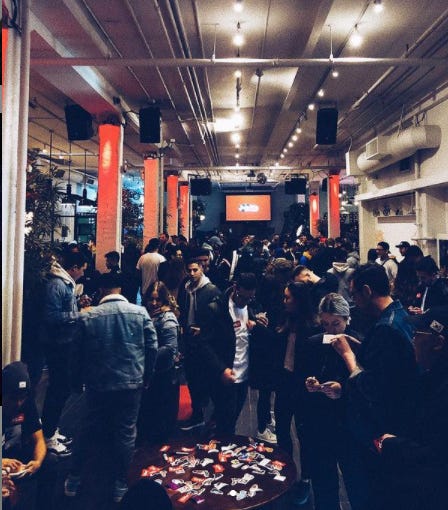Hi Friends! Welcome to the Consumer Startups community where we share stories about early-stage B2C startups and insights from the best consumer investors. All my previous posts can be found here.
If you aren’t subscribed yet, join a group of builders, founders, investors by subscribing here:
🔥 Startup Story
How to build a $1.5M ARR Slack community for sneakerhead
(Image credit: Solesavy)
“To be a successful creator you don’t need millions of anything. You don’t need millions of dollars, customers, clients, or fans. To make a living as a craftsperson, photographer, musician, designer, author, animator, app maker, entrepreneur, or inventor you need only thousands of true fans” - Kevin Kelly from Wired.
This statement was written 13 years ago, but still holds true today. Many creators are making a good living by producing interesting content and fostering an engaged community of fans. One of my favorite newsletter writers, Lenny Rachitsky, is making close to $500K a year writing about growth strategies to 50K readers while running an exclusive Slack community.
This community and content approach has also been wildly popular in the startup world. One notable example is SoleSavy - a private community for sneaker enthusiasts, aka sneakerhead, that raised a $2M seed last year. I chatted with Dejan Pralica, CEO and Co-Founder of Solesavy, to learn more about the founding story behind the community.
🌱Genesis
Dejan and his co-founder, Justin, have spent over 20 years collectively in the sneakers industry. Justin was the Director of Operations at New Age Sports, an authorized Nike retailer, and Dejan started Kicks Deals, a popular online resource for buying sneakers at or below retail. The idea for SoleSavy came from their own frustration with the industry.
“I’m a sneakerhead. I've been buying sneakers for a decade. In 2018, I was frustrated by the entire landscape because all the innovation happening in sneakers was around resale marketplace bots, which were about exploiting consumers rather than helping them. It got worse and worse over time. I decided to solve this problem myself by creating something that would bring value to a customer’s life and bring the culture together through a community,” Dejan said.
🚗 Product Journey
First experiment (2017):
SoleSavy started as an Instagram account. They posted their manifesto and the vision for the company they wanted to build - “We are here to enlighten, teach, and grow with you in an industry that continues to shift with each passing month. SoleSavy was created for you, the people. Not for bots. Not for resellers. It’s time that sneakers were put in the hands of the people who truly deserve them.”
Their initial goal was to grow the social following with people who aligned with that manifesto to a point where they could launch a product. They would post pictures about sneaker pictures and use different methods to really engage with their audience.
“We tried to bring value in that photo. Instead of just posting a picture of a cool sneaker, we would post it and explain why the shoe mattered in the hopes of teaching people something. Nobody was doing that at the time. At the same time, we did giveaways and contests. It was not the typical stuff. It was like ‘go learn and read something that we shared previously to find the answer’. We were trying to build an engaged audience base,” Dejan explained.
(An example of SoleSavy’s Instagram post in the early days)
Beta Launch (2018):
Slowly, Dejan and his team built up the Instagram account to over two thousand followers. They decided it was time to launch a slack community as a Beta. The launch didn’t come out of left-field - rather, it was carefully planned.
“We worked up to it and made it feel like an event. We held a launch party in an art gallery in Toronto. About 100 people attended that event. We had a security person managing the door since there was a line of people trying to get in. We were trying to build momentum and make it feel as special as possible.”
(SoleSavy’s Iaunch event in Toronto)
After the launch party, they released a signup sheet for their Instagram followers to sign up for the private and paid Slack community.
“We wanted to understand what the product might look like with the Beta and we needed 50 people. We had an HTML page with our logo on it and a Paypal button for payment. Within a minute, all 50 slots on the website were sold out.”
Product Iterations:
Following the launch, they spent the next 16 months slowly building the product, trying to understand the ins and outs of a community business.
“It's a lot of small iterations, and we didn't focus on growth at all. We grew incrementally - some months we added 30 people, and some months, we added 150 people. We focused on understanding the customers and the product before trying to move too fast.”
The product, at its core, is a Slack group with multiple cohorts. It’s a mix of a Twitter feed, RSS feed, and community discussion forum. They also built technologies that would give people real-time notifications on sneaker releases and teach people where and how to buy them quicker. Learn more about the features here.
Growth phase:
Then, COVID happened. By then, they had already figured out the product and the proper way to scale the product without ruining the core of who they were. They went from 1500 members to 5000 over the span of 2020. Currently, they are doing $1.5M from membership and affiliate revenue with >90% DAUs.
Next phase of SoleSavy:
As the community continues to grow, Dejan and his team are now thinking about the future of the product. They recently raised a $2M seed round and hired a Director of Engineering to help them build a product that will sit on top of the Slack community they have built.
📚 Key Learnings
Learning about a community takes time
“Building a community is difficult because you can’t just tell people to join a community. It took me 16 months to really understand how to build a community. You have to genuinely understand every aspect of your customer base to be able to properly grow a community. If you put yourself in their shoes, you'll be making decisions and thinking through what you're building based on their experience versus what you're trying to push, which is very hard for people to think about because a business doesn't normally operate that way.”
You can get a lot more done in a year than you think
“You can do anything if you put your mind to it, just set incremental goals and stay focused on that path you set out for yourself. The analogy is like doing dishes. You are like ‘oh, I don’t want to clean the dishes because it’s going to take too much time.’
Press the timer, do the dishes, and see how much time has passed. It’ll be like four minutes, whereas it mentally feels like it's gonna take you an hour. Business can feel the same way. Some things will take a year, but some things might just take you an hour to do. Focus on something that will move you forward right now, and keep building upon that every single day.”
🚀 Vision
“The vision is to create an end-to-end commerce platform that is social, truly peer-to-peer, and rooted in people versus the product itself. Instead of us pushing and selling sneakers, we're highlighting people who have collections of sneakers and letting that natural human curiosity lead to transactional sales of the product. It’s not fun if it becomes too transactional.”
Check out SoleSavy!
👨💻 What I’ve been reading
Man quits $20k Singapore job to build own startup, matches previous salary after 3-year grind (story of Bannerbear)
What it will take to kill Turbotax - distribution, perception, and quality (hint - consumer finance companies have the best shot to do so)
Merritt from Bain Capital Ventures shared a great article on how to monetize a B2B marketplace - some of my favorites include embedded financial services, sampling fees, and private-label products
Future of pet tech (Drivers, trends, and opportunities) by Lerer Hippeau
😍 Jobs & Internships
Full-time:
Lerer Hippeau - VC Associate (NYC)
Stir - Product Engineer (Remote)
Chapter One - Crypto Investor (Remote, LA)
Coda - Growth Associate Program (Remote, Bay Area)
Ramp - Business Operations Associate (NYC)
Better - Ops Associate (Oakland)
Internship:
Algorand - Technical Product Management Intern (Boston)
Modern Treasury - Growth Intern (Remote)
Reddit - Communications Intern (Remote)
Zoom - Marketing Intern (San Jose)
WHOOP - Biz Intelligence Intern (Boston)
Chipper Cash - Product Design Intern (SF, Remote)
Please share this newsletter with your friends if you liked the content today!





